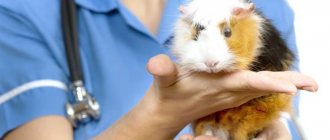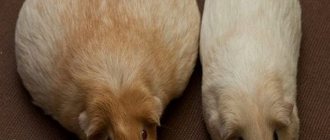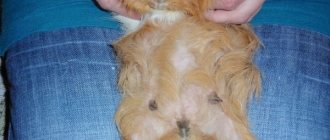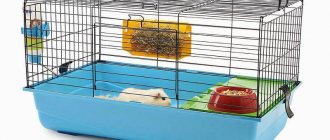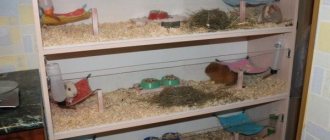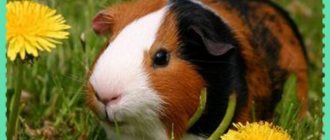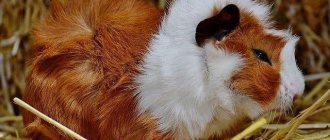!!! The guinea pig is a herbivore, so it does not have fangs. There are 2 incisors below and above, also 2 premolars and 3 molars on the left and right on both jaws. Therefore, the answer to the question of how many teeth a guinea pig has is 20. They grow throughout the rodent’s life. This has an evolutionary meaning: the animal is constantly gnawing and chewing something. If the guinea pig's teeth did not constantly grow, then by the second year there would be nothing to chew.
In a healthy pig, the length of the teeth and the shape of the upper edge can change throughout life: this depends on the animal’s diet. With the right diet, you don’t need to worry about your teeth - their length will adjust on its own.
Dental problems in guinea pigs
Guinea pigs are immune to tooth decay, but just like humans, they can have an abnormal bite. It is formed due to genetic mutations. Therefore, breeders do not recommend mating animals of the same family. Dental diseases also occur for the following reasons:
- teeth break off due to gnawing on the metal bars of the cage : this occurs due to the fact that the guinea pig does not have enough roughage or there are no twigs on which it can grind its teeth;
- due to the fall of the animal, its teeth break off , shift, or sink into soft tissues;
- the incisors grow so long that they cut into the cheeks, causing an abscess . This is the result of a lack of roughage or feeding with easily digestible food, which is why the guinea pig quickly becomes full and there is no need to chew;
- teeth wear down too quickly - a sign of vitamin C deficiency, as a result of which the tissue does not have time to form;
- break off, split, crumble - lack of calcium;
- the roots lengthen - this happens when the animal eats hay treated with herbicides. These substances contain fluoride, which accumulates in the guinea pig's body and leads to lengthening of the roots of the teeth;
- During the aging process, teeth shift and eating becomes impossible.
Treatment of dental diseases
The method of treatment depends on the type of pathology and the degree of damage:
- As a result of grinding the incisors against the bars of the cage, falling, or fighting with another pet, the teeth can be damaged. Small chips are not a cause for concern. But if the incisors crumble, split down to the gum tissue, or have sharp edges that damage the cheeks, you need to consult a veterinarian. The doctor, under anesthesia, using a special tool, grinds the edges. After this procedure, the animal should be given only soft food for several days, and food rich in calcium and vitamin C should be included in the diet.
- If a guinea pig has lost 1-2 teeth, this is not a pathology. If you lose more elements of the dentition, you need to show your pet to a veterinarian. The cause of tooth loss may be gum disease or calcium deficiency. These pathologies must be treated.
- Correction of malocclusions is carried out under anesthesia. For an accurate diagnosis, an x-ray is taken, the fistulas are removed, the flux is removed, the incisors are ground down, and an elastic bandage is applied to give them the correct position.
- When roots grow into the nasal cavity, tumors and foci of inflammation appear. Pathology is diagnosed by radiography. If the anomaly is minor, the crowns are trimmed. In difficult cases, the tooth is removed. To restore the muscles of the muzzle, an elastic bandage is applied.
- A common disease is cheilitis. If a guinea pig has a deficiency of vitamins A, C, or reduced immunity, fungal microorganisms multiply in the oral cavity. A hard coating of green, brown, red or yellow appears on the enamel of the incisors and lips. It is useless to remove it; the crust will form again. You need to show your pet to the veterinarian, he will select the right medicine.
Symptoms of dental diseases
An attentive owner will quickly detect dental disease in a guinea pig. Vivid symptoms:
- the animal chews as if it is about to spit out the food;
- when chewing, the ears move strongly;
- purulent mucus is released from the nose and ears;
- the guinea pig chews food on one side of its teeth;
- the upper incisors protrude strongly from the mouth;
- she began to chew more slowly than before;
- chews the skin of an apple not as quickly as its pulp;
- Unchewed pieces fall out of the mouth;
- spits food back;
- the pig squeaks from hunger, sniffs the food, but does not eat it;
- drooling heavily;
- the animal has lost weight;
- the incisors are beveled to one side;
- seals on the cheeks or on one side;
- The pig's tears are flowing.
A combination of several symptoms will help clarify the picture of the disease. An accurate diagnosis will be made by a veterinarian when examining the animal.
Causes
The reasons can be either genetically determined or acquired.
In the first case, this may be the consequences of violating the rules of crossing (closely related variant) due to the fault of the breeder.
In the second case, the wrong diet is to blame. If the owner gives his pet food that is tastier (in his opinion), and often pampers him with soft dry food and store-bought treats, then the balance between rough and soft food is upset, the teeth stop grinding down, but do not stop growing. And then the above-described dental problem arises.
Choose food for guinea pigs in the catalog.
Diagnostics
The initial examination takes place without anesthesia. An assistant gently holds the guinea pig while the veterinarian examines the oral cavity. If there are obvious painful symptoms, the rodent is examined under general anesthesia. The doctor feels the cheeks and takes an X-ray of the jaws. This is how root growth is detected, because visually everything is normal, but it hurts the pig to chew.
When to see a doctor
The most common reasons for visiting a doctor are:
- Uneven chipped tooth
- Very sharp edge of a broken tooth,
- Damage to the oral mucosa,
- The appearance of purulent wounds and ulcers on the gums,
- Increased salivation
- The appearance of an unpleasant odor from the animal’s mouth,
- The appearance of signs of the wrong sign,
- Lack of appetite,
- Simultaneous loss of more than three teeth.
All these reasons are easy to identify when examining the oral cavity. Only a veterinarian can correct the situation and prescribe, if necessary, proper treatment and nutrition. Self-medication can make the situation worse.
Treatment: broken tooth
People with a broken tooth go to the vet in 3 cases:
- the edge damages soft tissue, which creates a risk of an abscess;
- the tooth splits, which threatens the integrity of the root and complete loss;
- the broken edges are smooth, but they crumble.
In the first case, the doctor will trim the edge of the tooth. For this purpose, a special tool is used - bone forceps. It is strictly forbidden to do the procedure yourself: you need anesthesia, knowledge of how to grip correctly, and only this instrument. After the procedure, as well as in the other two cases - splitting and crumbling, the guinea pig is introduced to the diet with calcium and vitamin C. For the first 2 weeks, crushed food is served so that the animal can eat fully without pain. Buy calcium at a veterinary pharmacy: Calcidi, 1/3 tablet daily.
If the edges of the tooth are smooth, you can help your guinea pig at home: give a quarter of a vitamin C tablet (100 mg) daily.
How to take care of your teeth
Teeth do not require special care. They wear down due to the presence of hay and young thin twigs in the diet. The fact that the chewing apparatus is in order is indicated by the pet’s good appetite.
Important! The basic dental rule that applies to a guinea pig's mouth is that if the guinea pig's weight does not change and she is actively feeding, then her teeth are fine.
But if you notice that your pet is eating cautiously or has begun to avoid certain types of food, then you will need the help of a veterinarian.
Elongated roots and malocclusion
In both cases, the pig is given a tight elastic bandage with which it must sleep overnight. The tourniquets put pressure on the jaw apparatus, which is why the animal tries to resist the pressure. As a result, the muscles become stronger, the teeth compress tightly and begin to wear down. Sometimes the veterinarian files the teeth and then puts on a bandage. After this, the incisors and molars grow to the required length with adjustments. The duration of wearing the elastic bandage is determined by the veterinarian. In parallel with this, it is recommended to massage on each side of the jaw: lightly massage with your fingers for 2 minutes.
Help with teeth at home
You can try to pull out a broken tooth with your fingers. It hurts the pig more when it cuts the gum than when it is removed. There is no need to be afraid that a healthy tooth will come out - this one will sit firmly. After the procedure, you need to lubricate the animal’s gums with Iodinol. If after such manipulations the pig cannot eat even chopped food, it is necessary to feed it from a syringe: 6 g of food for every 100 g of weight.
If the teeth have shifted due to old age of the guinea pig, then the only way out is to feed it liquid food from a syringe for the rest of its days.
Prevention
Normally, the upper incisors are 1.5 times shorter than the lower ones: the lower ones are about 1 cm, the upper ones are 0.6-0.7 cm. You need to constantly monitor these parameters. Also, the following rules will help avoid dental problems:
- Take care of your pet. Train young children to handle your guinea pig so that they do not drop it. If your baby is afraid to pick up an animal, let him play with it on the floor or pet it from your hands. Falls can cause serious dental injuries.
- Watch the diet: the pig needs to be fed both cereals and hard root vegetables. Place branches of fruit trees so that the animal can gnaw on them.
- For pregnant females, introduce calcium and vitamin C into the diet. This is the prevention of genetic dental disorders in future offspring.
- Avoid crossing animals with consanguinity to eliminate problems with genetics, which manifests itself in the form of malocclusion.
Video:
ARTICLE 2: Guinea pig purrs when petted: how to pet it correctly
Symptoms of dental diseases
When problems with teeth appear, the general condition of the pet worsens. She loses her appetite, loses weight, and over time her body becomes exhausted.
This can even lead to death, so you need to notice the symptoms of diseases of the dental system in time:
- difficulty swallowing food;
- excessive salivation (hypersalivation);
- refusal of solid food that falls out of the mouth; the animal can also spit it out;
- chewing load on one side of the jaws;
- constant movement of the ears while eating;
- grinding or chattering of teeth;
- inability to completely close your mouth;
- diarrhea or constipation due to improper chewing or swallowing of food;
- incorrect placement of the incisors, protruding them in different directions, grinding at a certain angle;
- the appearance of blood in saliva;
- sores or fistulas in the mouth;
- swelling in the cheek area (abscess or neoplasm);
- loose teeth;
- copious discharge from the nose or eyes.
While chewing food, a guinea pig makes a sound that is similar to a cough; it puts its paws in its mouth in an attempt to get out hard pieces. While chewing, the teeth creak, dark spots and bevels appear on the incisors, they are very long, crumble, bend inward or diverge to the sides.
Weight is steadily decreasing, which can be determined by regular weighing. The fur on the neck becomes wet due to excess saliva production. Sometimes you can hear something gurgling or wheezing in the nasopharynx. Stools are unshaped, irregular or small, indicating malnutrition.
If such problems occur, you should take your pet to the veterinarian.
Important! The front teeth are considered healthy if they are white and have even edges. If their ends are beveled, then this indicates problems.
